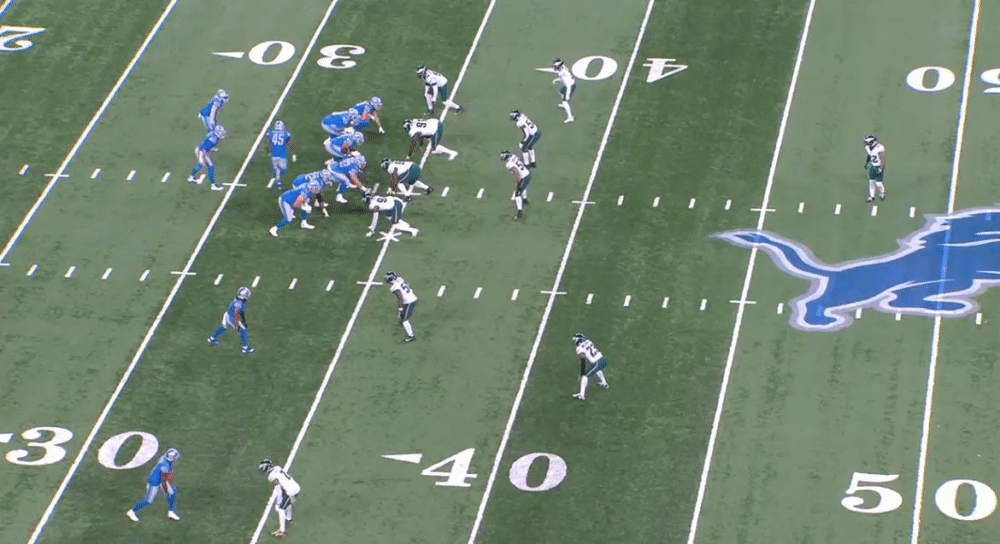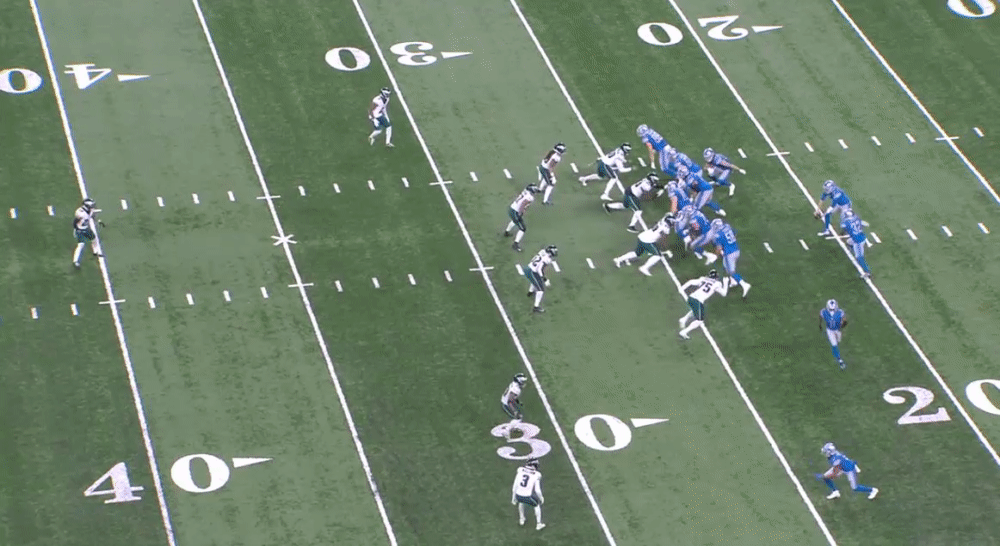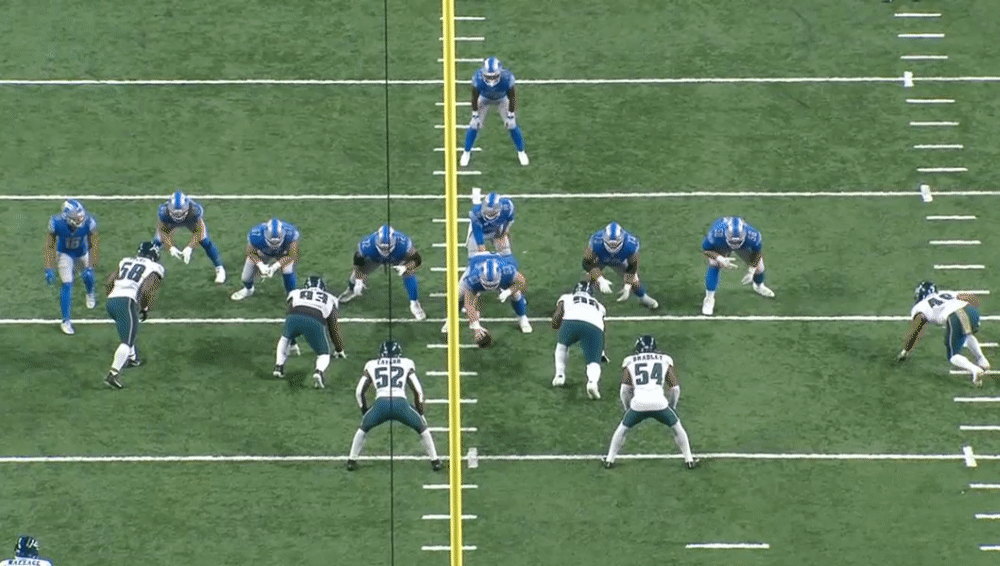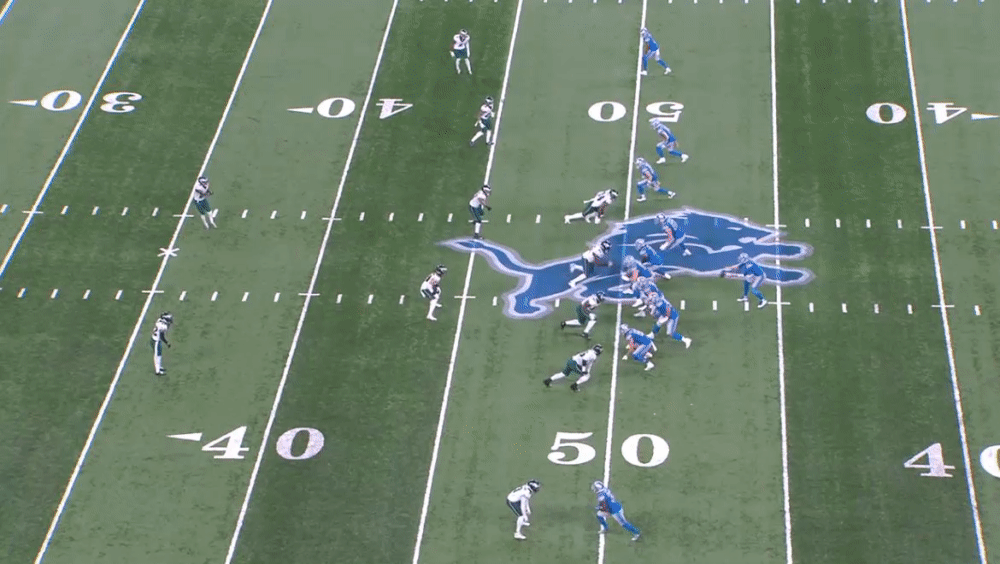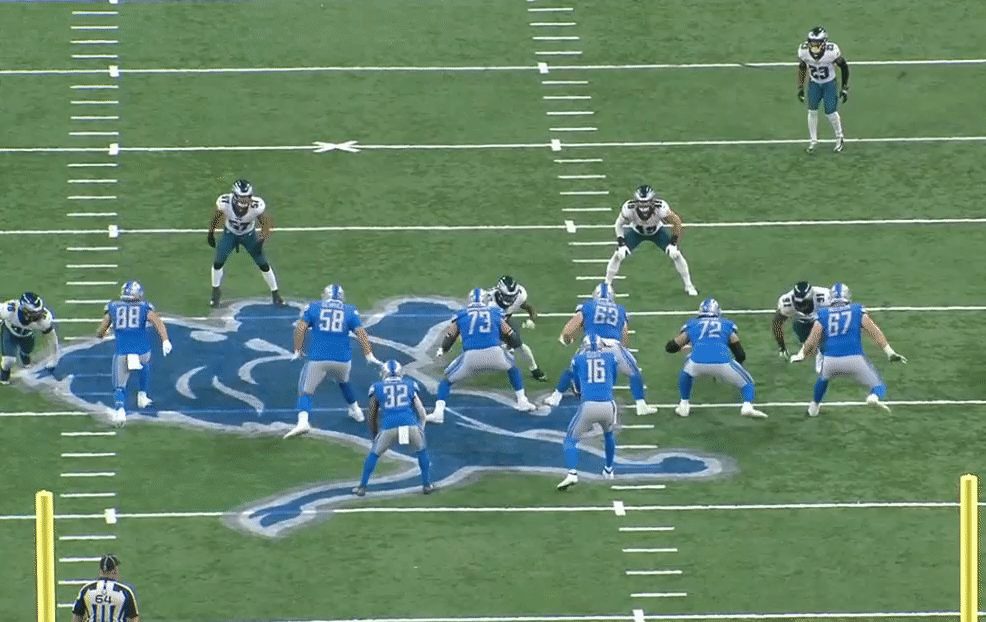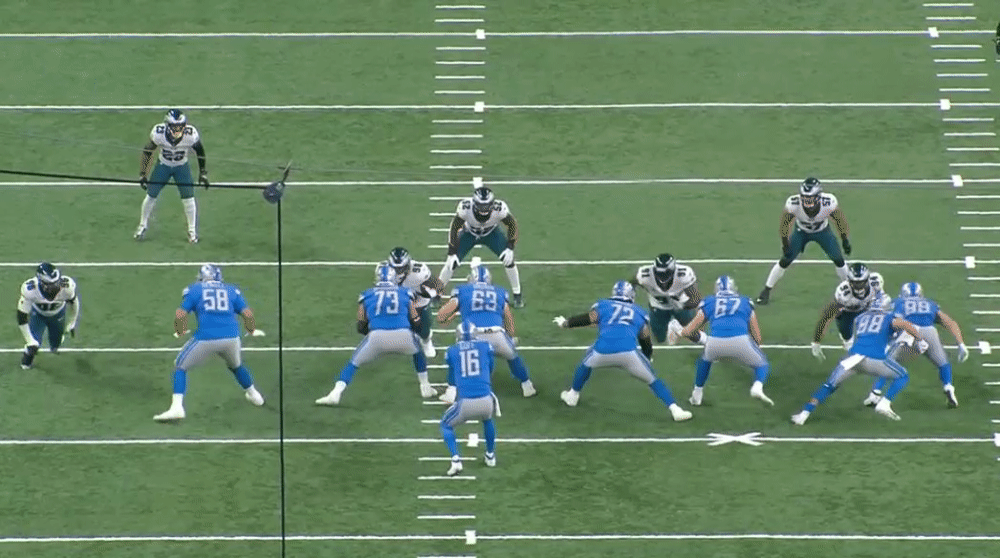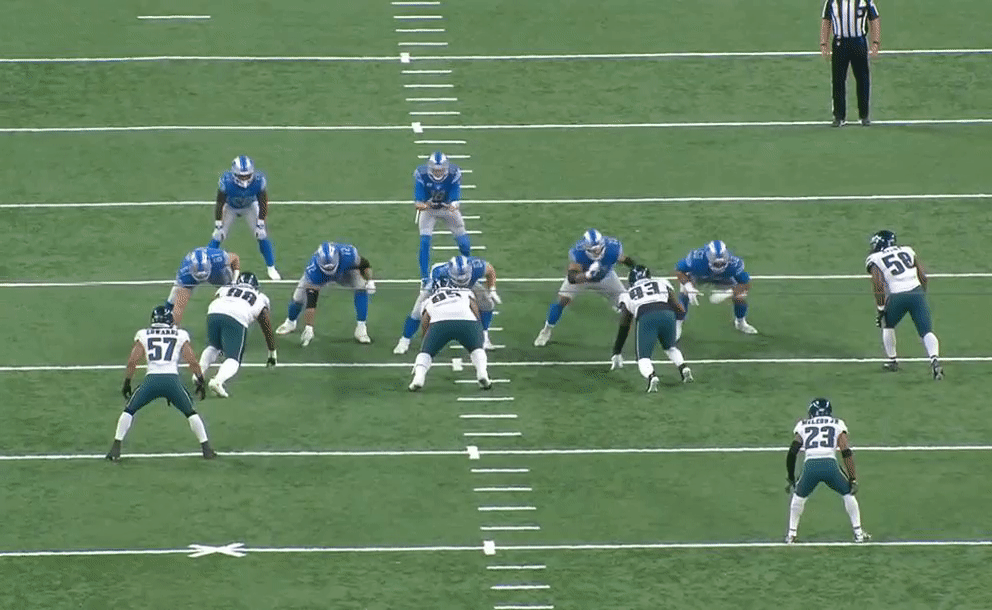Allen Park — People have asked, why are you reviewing the film for a winless team coming off a blowout loss? It’s a reasonable question. It’s not enjoyable work, that’s for sure, but the best way to answer the question is I’m trying to get in the same headspace as the team when they go through the exact same process after each game.
I’m digging deep for the “why” things happened the way they did, good or bad. In the case of Sunday’s 44-6 loss to the Philadelphia Eagles, there obviously wasn’t much positive to pull from the tape. But it’s important for me, as a reporter, to understand what went so wrong for this past weekend and what, if anything, can the Lions do to fix it.
And while the offense and defense both shoulder plenty of culpability for this disastrous performance, I determined it would be best to focus on the offense since that was what coach Dan Campbell emphasized in his postgame comments, when he called the unit anemic and said he was going to look that film over three times before evaluating anything else.
So after watching all 62 snaps, here’s some position-by-position observations from the performance, with an understandably decreased emphasis on the late-game touchdown drive when the Eagles were already up 41 points and ready to get on a plane home.
Quarterback
In a radio interview with 97.1 The Ticket on Tuesday morning, Campbell said he didn’t feel like Jared Goff was the issue in this game. After reviewing the tape, it’s difficult to disagree with the coach’s assessment.
It’s not unusual for the quarterback to draw the brunt of fan frustrations — and Goff has unquestionably had his share of struggles this year — but it was difficult to find too many flaws with his execution in this one, given what he was working with.
The Lions wanted to be more aggressive with their downfield passing attack and opened the matchup with four vertical options, which saw Goff find T.J. Hockenson for an 18-yard gain down the seam.
Unfortunately, that ended up being the team’s second-longest play of the game as the Eagles’ coverages took away the majority of Detroit’s remaining downfield looks. To his credit, Goff didn’t force the ball into nonexistent windows. It’s been talked about plenty, but with such a slim margin for error, the team can’t afford unforced turnovers.
Instead, as he’s accustomed to doing, Goff settled for checkdown throws in those situations. This wasn’t a case of him being afraid or too conservative to push the ball vertically, it was the QB being smart and making the right reads.
As usual, outside of a handful of checkdowns, Goff primarily threw to his first read, which far too often was Hockenson. This falls on game-planning, which we’ll get into a bit more later, but the offense was far too reliant on the Pro Bowl tight end to carry the passing game.
Goff’s lack of mobility also continues to show up regularly. While Philadelphia’s Jalen Hurts regularly ran away from Detroit’s pass rushers, avoiding being sacked all afternoon, Goff was dropped behind the line five times.
In the past, Campbell has criticized his quarterback for holding onto the ball too long in some of those situations, but there was only one, maybe two, where Goff could have done a better job getting rid of it before the pressure got home.
Running backs
Watching from the end zone view, compared to the sideline angle provided by the broadcast, gives you a far better sense for what the running back sees. And in the case of D’Andre Swift, who led Detroit’s backfield charge, one thing he didn’t see was many viable lanes.
Leading the team with 12 carries, Swift finished with 27 yards as the Eagles smothered him at or behind the line of scrimmage much of the afternoon. Swift did a fine job reading the leverage of his blockers and improvising when necessary, but there wasn’t much yardage to be had before contact.
In close quarters, Swift continues to offer little after he’s hit. He rarely makes a man miss in the hole or run through the contact of a defensive lineman or linebacker. In the passing game, he’s traditionally been more elusive, but not in this one. On one pass, he stumbled making the catch, potentially costing him 15 or more yards. On another, he got dropped in the open field while one-on-one with a defender.
Swift’s biggest error, even though the game was already out of reach, was allowing the ball to be punched out by cornerback Avonte Maddox, resulting in a touchdown for the Eagles after Darius Slay scooped up the loose ball and brought it back 33 yards.
Detroit’s other backs showed some promise in limited work. Godwin Igwebuike turned a short pass into an 18-yard gain at the end of the first half, taking advantage of the defense giving extra attention to Hockenson.
And rookie Jermar Jefferson, making his debut on offense, had a pretty 8-yard touchdown run, using his blocks to weave through the heart of the Eagles defense. He also contributed in the passing game, serving as a checkdown option for Goff on a couple of occasions.
From the fullback perspective, Jason Cabinda was largely ineffective, including a couple of badly blown blocks that sabotaged Swift carries.
Wide receivers
Detroit’s receivers were largely a nonfactor and, for the most part, didn’t even seem to be part of Goff’s passing progressions.
The lone exception was rookie Amon-Ra St. Brown, who found some space running crossing patterns and feeding off the extra attention the Eagles were giving to Hockenson and Swift.
Near the end of the first half, St. Brown gained 35 yards on a well-designed concept that had him running parallel to Hockenson, but a couple yards deeper in the opposite direction. When the Eagles committed a second defender to the tight end, it created a window for Goff to feed the rookie across the middle for a big gain, but the play ended up being wiped out by an illegal formation.
St. Brown similarly capitalized on the defense funneling to Swift, gaining 34 yards running a crossing pattern on Detroit’s first offensive snap of the second half.
St. Brown added a couple more catches on out patterns, including a contested catch on third down where he extended the ball to the marker to prolong the possession.
Trinity Benson and Kalif Raymond looked to largely be decoys, occupying defenders deep and shallow depending on the play design. KhaDarel Hodge got a couple designs, but he dropped one pass across the middle and had a deep throw go off his fingertips on a would-be touchdown.
The blocking by the receivers also left plenty to be desired. St. Brown lost his man on a screen pass to Hockenson, resulting in a third-down play failing. Tom Kennedy also failed to dig out a safety from the slot, resulting in a rare well-blocked Swift run to be stopped well short of its maximum potential.
Tight ends
Hockenson, as the primary option in the passing game, was predictably steady, having most of his success running out patterns from the slot after the seam route to open the game. The Eagles aggressively and effectively took Hockenson away across the middle after that early grab, often bracketing him with a second defender.
He did put one ball on the ground he shouldn’t have, when the defender arrived early on a third down but didn’t affect the tight end’s ability to make the catch. He also had a false start, his third of the year.
As a run blocker, Hockenson was below average, whiffing on a couple of assignments — one on a pull block on a sweep and another in the second level on a draw — that cost Swift yardage.
With veteran Darren Fells scratched from the lineup, the Lions gave 16 snaps to rookie Brock Wright, who blocked well enough but wasn’t targeted in the pass game. He was, somewhat surprisingly, the primary read on two deeper routes but was taken away by the coverage on both snaps.
Offensive line
If there was one position group most responsible for Detroit’s struggles, it was the blocking, with the right side having a particularly brutal day.
Right tackle Matt Nelson had one of his worst performances of the season, allowing several pressures and a couple sacks. The first came when Eagles edge rusher Josh Sweat dipped under Nelson’s block and dropped Goff for a 5-yard loss five minutes into the game, effectively ending Detroit’s second possession.
Nelson was less responsible for the second sack, losing his balance after Hockenson stepped on his foot, which allowed Sweat to plow through the line on third down and plant Goff for a loss of 12.
Additionally, Nelson had a couple ugly snaps as a run blocker. Early in the game he got tangled up with Halapoulivaati Vaitai and both went down, leaving Swift to get stopped after a gain of 1 yard. And Nelson lost backside contain on another as Jefferson got caught from behind and tackled for a 2-yard loss on his first NFL carry.
Vaitai, center Evan Brown and right guard Jonah Jackson all had sloppy pass-blocking reps, resulting in negative plays that put the Lions behind the sticks or contributed to drives being ended prematurely.
Brown got driven deep into the pocket when Goff was sacked on fourth-and-1 at the end of the first half and also drew a hold when he was badly beat on a third-down snap in the third quarter, negating a first-down conversion.
Jackson was beat by Hassan Ridgeway’s swim move late in the third quarter, resulting in a sack and Goff fumbling on second down.
And Vaitai, in addition to a couple of troubling run blocks in the first half, including one where he bounced off linebacker Gerard Avery while pulling despite a 70-pound weight advantage, allowed pressure to Fletcher Cox on a fourth down that resulted in Goff rushing a throw that sailed on him and landed out of bounds.
Coaching
When discussing the Lions’ limited margin for error, dumb penalties are part of that equation. It was particularly troubling to see the Lions called for an illegal formation — covering up the tight end — for the second time in three weeks. That wiped out a long completion into the red zone, which conceivably took points off the board. It’s inexcusable.
In addition to that error, it’s worth going back to the overreliance on Hockenson. It’s an easy trap to fall into with such little offensive talent, but the two big gains to St. Brown showed how to use your best players as decoys. The Lions simply didn’t do it enough, and it’s troubling how little the outside receivers were involved in the game plan. No matter how strong a player is mentally, it has to be tough to play 45 snaps and not see one throw your direction. How do you expect a player to stay fully engaged?
There were at least a couple calls, including an attempted tunnel screen to Swift, that flat out didn’t work. Penei Sewell is as athletic as they come for the offensive tackle position, but he wasn’t physically able to reach his blocking assignment, dooming the play. And on a third-and-1 run late in the first half, with St. Brown and Raymond tight to the formation, both receivers tried to block the same defender. That left a man free to stop Swift short. That has to be coached better.
Finally, the end of the half sequence was rough, something Campbell already acknowledged. When Swift didn’t get out of bounds with 32 seconds remaining, it was a mistake to not use a timeout. Plus, the already questionable decision to go for it on fourth-and-1 looks so much worse when the design took far too long to develop, contributing to the sack. With a timeout in your pocket, how do you not have a checkdown progression for Goff at the sticks?
jdrogers@detroitnews.com
Twitter: @Justin_Rogers
